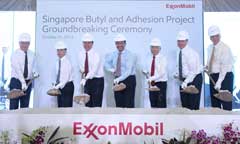
US chemical firm ExxonMobil Chemical recently held a ground breaking ceremony on the building of two new speciality polymers units at its Singapore Chemical Plant. This comes just ten months after celebrating completion of its major petrochemical expansion in Singapore http://www.plasticsandrubberasia.com/may2013/company22.html
ExxonMobil says it is now ready to construct new halobutyl rubber and hydrogenated hydrocarbon resin production facilities on the Jurong Island site. Work is expected to be completed in 2017 and will add about 140 new jobs to the existing workforce of more than 2,000 at the integrated manufacturing site.
“Our expanded steam cracking capability at Singapore provides a platform for growth through a wide range of petrochemical building blocks that can be further upgraded to speciality products, such as halobutyl rubber and adhesive resins,” said Neil Chapman, Senior Vice President, ExxonMobil Chemical Company.
At the ceremony Chapman added: “ExxonMobil’s Singapore Chemical Plant is the optimal base for serving the fast growing market in Asia with advantaged feedstock, economies of scale, and excellent logistics.”
The company is a major supplier of halobutyl rubber to the global tyre industry, and this expansion project will add production capacity of 140,000 tonnes/year. Though the automotive industry worldwide has been stagnating, according to ExxonMobil's energy outlook, the number of cars and light trucks globally is expected to double to 1.7 billion vehicles by 2040, supporting much of the growth expected for halobutyl rubber.
The ExxonMobil capacity is in addition to that of German competitor Lanxess that inaugurated its new butyl rubber plant on Jurong Island in Singapore last year. It has a capacity of 100,000 tonnes/year and produces premium halobutyl rubber, as well as regular butyl rubber.
Hydrocarbon resin plant to meet future demand
Meanwhile, the hydrogenated hydrocarbon resin production unit will be the world’s largest, with a capacity of 90,000 tonnes/year, to meet long-term demand growth for hot-melt adhesives. The new plant will nearly double the company’s capacity to manufacture high-performance Escorez 5000 resin for hot melt adhesive producers worldwide. This will make the new plant 40% bigger than the industry’s largest hydrogenated tackifier plants today.
The Singapore plant’s two large steam crackers utilise proprietary technology to process a range of feedstocks, including crude oil. Crude cracking produces a wide range of valuable byproducts that can be further upgraded to speciality chemicals such as resins for adhesive applications. The facility incorporates a hydrogenation reactor system to produce premium tackifiers. The plant will also produce new resins for non-adhesive uses.
Hydrogenated tackifier demand is expected to double over the next 15 years. Much of the growth is forecasted in Asia, where packaging, woodworking and nonwovens manufacturers increasingly depend on the performance and cost effectiveness of hot melt adhesives.
ExxonMobil Chemical has continuously increased its hydrogenated resin capacity since the 1970s with innovations in process technology. With current tackifier production in Baton Rouge, US, and Notre-Dame-de-Gravenchon, France, the new Singapore plant is a strategic addition in global production of Escorez 5000 resin.
(PRA)






















